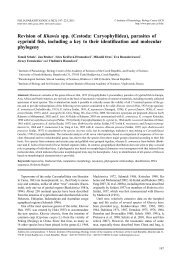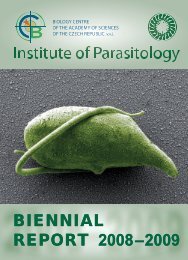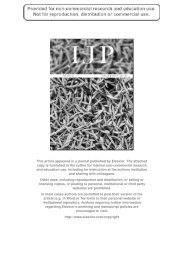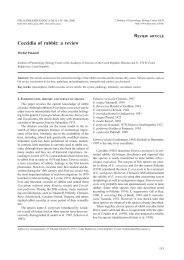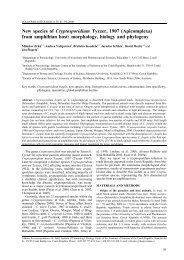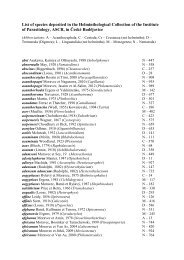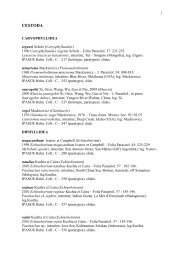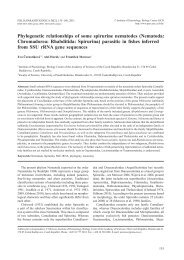Ahead of print online version Two species of Rhabdochona ...
Ahead of print online version Two species of Rhabdochona ...
Ahead of print online version Two species of Rhabdochona ...
Create successful ePaper yourself
Turn your PDF publications into a flip-book with our unique Google optimized e-Paper software.
Remarks: the presence <strong>of</strong> 14 anterior prostomal teeth,<br />
filamented eggs and a sharply pointed female tail in the<br />
present specimen show that it belongs to the nominotypical<br />
subgenus <strong>Rhabdochona</strong>. Of the five <strong>species</strong> <strong>of</strong><br />
this subgenus so far reported from iraq (see above), four<br />
have filamented eggs: R. gnedini, R. hellichi, R. similis<br />
and R. tigridis. <strong>of</strong> them, only R. gnedini and R. hellichi<br />
are typically parasites <strong>of</strong> barbels (Barbus spp.) and some<br />
cyprinids <strong>of</strong> related genera (Moravec 1975, Moravec et<br />
al. 2010), whereas the type host <strong>of</strong> R. similis is the catfish<br />
Glyptothorax sp. (sisoridae, siluriformes) (see Moravec<br />
et al. 1991) and the main hosts <strong>of</strong> R. tigridis are Capoeta<br />
spp. (cyprinidae, cypriniformes) (see Moravec et al.<br />
2009, Bilal and Abdullah 2010).<br />
dISCuSSIoN<br />
Bilal and Abdullah (2010) reported large numbers <strong>of</strong><br />
adult nematodes from Barbus barbulus and Luciobarbus<br />
kersin from the Bahdinan river (tigris river basin),<br />
northern Iraq, identified as R. chodukini. However, this<br />
identification seems to be wrong, as visible from their<br />
description <strong>of</strong> these specimens, because some reported<br />
features, e.g., the presence <strong>of</strong> cuticular outgrowths on<br />
the male tail tip, do not agree with the morphology <strong>of</strong><br />
144<br />
<strong>Ahead</strong> <strong>of</strong> <strong>print</strong> <strong>online</strong> <strong>version</strong><br />
Fig. 3. <strong>Rhabdochona</strong> (<strong>Rhabdochona</strong>) sp. from Luciobarbus kersin, female. A – anterior end, lateral view; B, C – cephalic end, lateral<br />
and apical views; d – tail, lateral view; e – deirid; F – egg.<br />
R. chodukini (see Moravec 1975). Despite some biometrical<br />
differences reported in the inadequate description <strong>of</strong><br />
the specimens in question, it is highly probable that these<br />
nematodes belonged in fact to the new <strong>species</strong> R. kurdistanensis.<br />
in iraq, Moravec et al. (2009) reported <strong>Rhabdochona</strong><br />
(Globochona) sp. fourth-stage larvae from the intestine<br />
<strong>of</strong> B. barbulus (prevalence 44%, mean intensity 19) and<br />
L. kersin (50%, 27) from the Kurdistan region (Bahdinan<br />
river, tigris river basin), and from Cyprinion macrostomum<br />
(only 1 specimen found in 1 fish examined) from the<br />
tigris river at Mosul. there is no doubt that these larvae<br />
were conspecific with R. (G.) kurdistanensis sp. n. the<br />
larvae reported by Moravec et al. (2009) from B. barbulus<br />
and L. kersin in Kurdistan were collected in November<br />
(unpublished), whereas the conspecific adults in L. kersin<br />
from the same region during June and July. this indicates<br />
that R. kurdistanensis may exhibit a pronounced seasonal<br />
cycle <strong>of</strong> maturation, when egg-producing females occur<br />
only in late spring and summer, as it was observed<br />
in some other <strong>Rhabdochona</strong> spp. in the temperate zone<br />
(Moravec 2010). Whereas both B. barbulus and L. kersin<br />
probably serve as definitive hosts <strong>of</strong> R. kurdistanensis, the<br />
finding <strong>of</strong> a single conspecific larva in C. macrostomum



